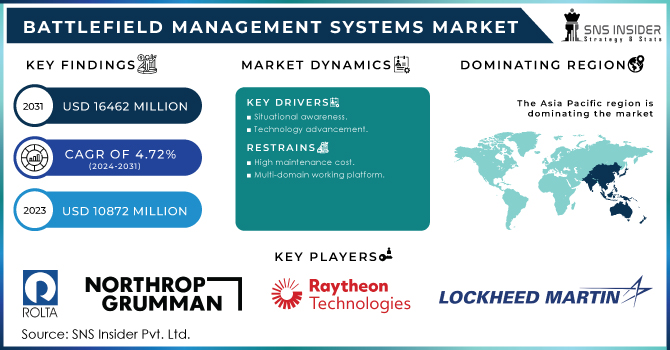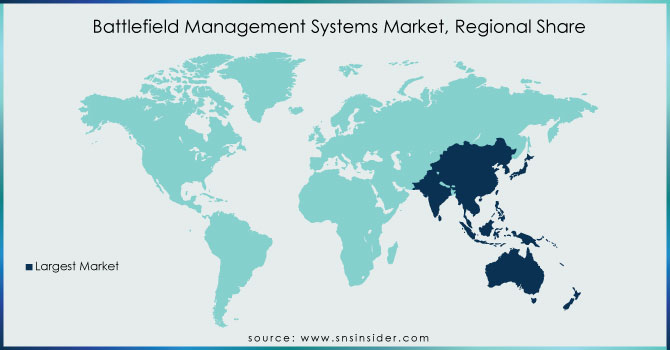Battlefield Management Systems Market Report Scope & Overview:

To get more information on the Battlefield Management Systems Market - Request Free Sample Report
The Battlefield Management Systems Market Size was valued at USD 10872 million in 2023, expected to reach USD 16462 million by 2031, and grow at a CAGR of 4.72% over the forecast period 2024-2031.
A battlefield management system integrates information gathered from real-time data on the battlefield and routes it to a military unit's surge command and controller. Battlefield management systems are important components of the Army's network-centric warfare program because they transmit information from groups on the battlefield to command headquarters. BMS may gather and send data, images, and audio from a variety of sources, including cameras, laser rangefinders, radar, and ground sensors, allowing soldiers on the battlefield to access real-time data for enhanced decision-making in tough situations. Each BMS contains a geographical information system, a multimodal data fusion system, rugged computing devices, and a software-defined radio-based communication system for soldiers.
Battlefield management systems are widely utilized in the defense industry because they enable decision-makers to detect, process, and evaluate crucial information from diverse sources during missions. Countries can improve their defense infrastructure by implementing battlefield management systems. Using battlefield management tools gives you a competitive advantage over your opponents. The defense industry's rapid adoption of battlefield management systems can be ascribed to the requirement to track the real-time position and movement of enemy units. Furthermore, as government investment from many countries increases, multiple manufacturers are engaged in the development of technologically advanced battlefield management systems that provide real-time situational awareness information for strategic decision-making.
MARKET DYNAMICS
KEY DRIVERS
-
Situational awareness
-
Technology advancement
-
Rising terrorist activity
RESTRAINTS
-
High maintenance cost
-
Multi-domain working platform
OPPORTUNITIES
-
Enhancing reliability
-
Real-time data collection
CHALLENGES
-
Efficient data centers
-
Lack of communication technology
IMPACT OF COVID-19
during the COVID-19 virus outbreak in December 2019, the virus has spread to nearly every country on the planet, prompting the WHO to called it a public health emergency situation. The disease's global impact is already being felt, and it is predicted to have a considerable impact on the global battlefield management systems market by 2020.
The COVID-19 epidemic has had an impact on critical defense operations such as conferences, joint exercises, drills, regular training, and recruitments, which has a direct impact on the expansion of the battlefield management market. The epidemic is predicted to have a detrimental influence on the worldwide battlefield management market in general.
The computing system segment is expected to expand at the fastest CAGR over the projection period. Several defense companies' requirements for sophisticated computer systems to support decision-making processes is boosting worldwide computing system segment growth. The army segment is expected to expand at the fastest CAGR during the projection period. This segment's growth is expected to be driven by the increasing use of battlefield management systems for real-time intelligence delivery.
There are several systems in the battlefield management system market category, including computer systems, communication and networking systems, and navigation and imaging systems. The battlefield management system market is concentrated in Asia-Pacific the Americas Europe, and the Middle East and Africa.
According to the report, the key drivers assist the worldwide market in reaching all geographical places. To expand its business in the areas, the worldwide market is also focusing on the Singapore battlefield management system.
KEY MARKET SEGMENTATION
By Platform
-
Headquarter
-
Command Centers
-
Soldier Systems
By System
-
Computing System
-
Navigation & Imaging System
-
Communication & Networking System
-
Command & Control Systems
By Component
-
Hardware
-
Software
-
Display Devices
By End User
-
Military
-
Air Force
-
Navy
By Installation Type
-
Upgradation
-
New Installation
REGIONAL ANALYSIS
During the forecast period, the Asia Pacific battlefield management systems market is expected to develop at the fastest CAGR. The Asia Pacific battlefield management systems market is expanding due to the region's major economies' increased focus on modernizing existing military systems. Furthermore, factors such as rising geopolitical tensions and increased defence spending are projected to stimulate demand for battlefield management systems in the region.

Need any customization research on Battlefield Management Systems Market - Enquiry Now
REGIONAL COVERAGE:
-
North America
-
USA
-
Canada
-
Mexico
-
-
Europe
-
Germany
-
UK
-
France
-
Italy
-
Spain
-
The Netherlands
-
Rest of Europe
-
-
Asia-Pacific
-
Japan
-
south Korea
-
China
-
India
-
Australia
-
Rest of Asia-Pacific
-
-
The Middle East & Africa
-
Israel
-
UAE
-
South Africa
-
Rest of Middle East & Africa
-
-
Latin America
-
Brazil
-
Argentina
-
Rest of Latin America
-
KEY PLAYERS
The Major Players are Rolta India Limited, Northrop Grumman Corporation, Raytheon Company, Collins Aerospace, Cobham PLC, Lockheed Martin Corporation, Thales Group, Atos SE, BAE Systems PLC, L3 Technologies Inc, and other players
| Report Attributes | Details |
|---|---|
| Market Size in 2023 | US$ 10872 Million |
| Market Size by 2031 | US$ 16462 Million |
| CAGR | CAGR of 4.72% From 2024 to 2031 |
| Base Year | 2023 |
| Forecast Period | 2024-2031 |
| Historical Data | 2020-2021 |
| Report Scope & Coverage | Market Size, Segments Analysis, Competitive Landscape, Regional Analysis, DROC & SWOT Analysis, Forecast Outlook |
| Key Segments | • By Platform (Headquarter, Vehicle, and Soldier) • By Platform (Armored Vehicles, Headquarter, and Command Centers, Soldier Systems) • By System (Computing System, Navigation & Imaging System, Communication & Networking System, and Command & Control Systems) • By Component (Hardware, Software, and Display Devices) • By End User (Military, Air Force, and Navy) • By Component • By Installation Type |
| Regional Analysis/Coverage | North America (USA, Canada, Mexico), Europe (Germany, UK, France, Italy, Spain, Netherlands, Rest of Europe), Asia-Pacific (Japan, South Korea, China, India, Australia, Rest of Asia-Pacific), The Middle East & Africa (Israel, UAE, South Africa, Rest of Middle East & Africa), Latin America (Brazil, Argentina, Rest of Latin America) |
| Company Profiles | Rolta India Limited, Northrop Grumman Corporation, Raytheon Company, Collins Aerospace, Cobham PLC, Lockheed Martin Corporation, Thales Group, Atos SE, BAE Systems PLC, L3 Technologies Inc, and other players. |
| DRIVERS | • Situational awareness • Technology advancement • Rising terrorist activity |
| RESTRAINTS | • High maintenance cost • Multi-domain working platform |

